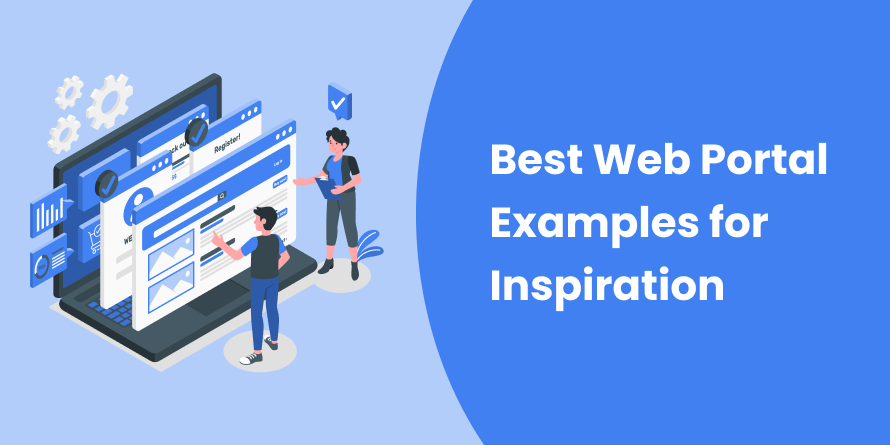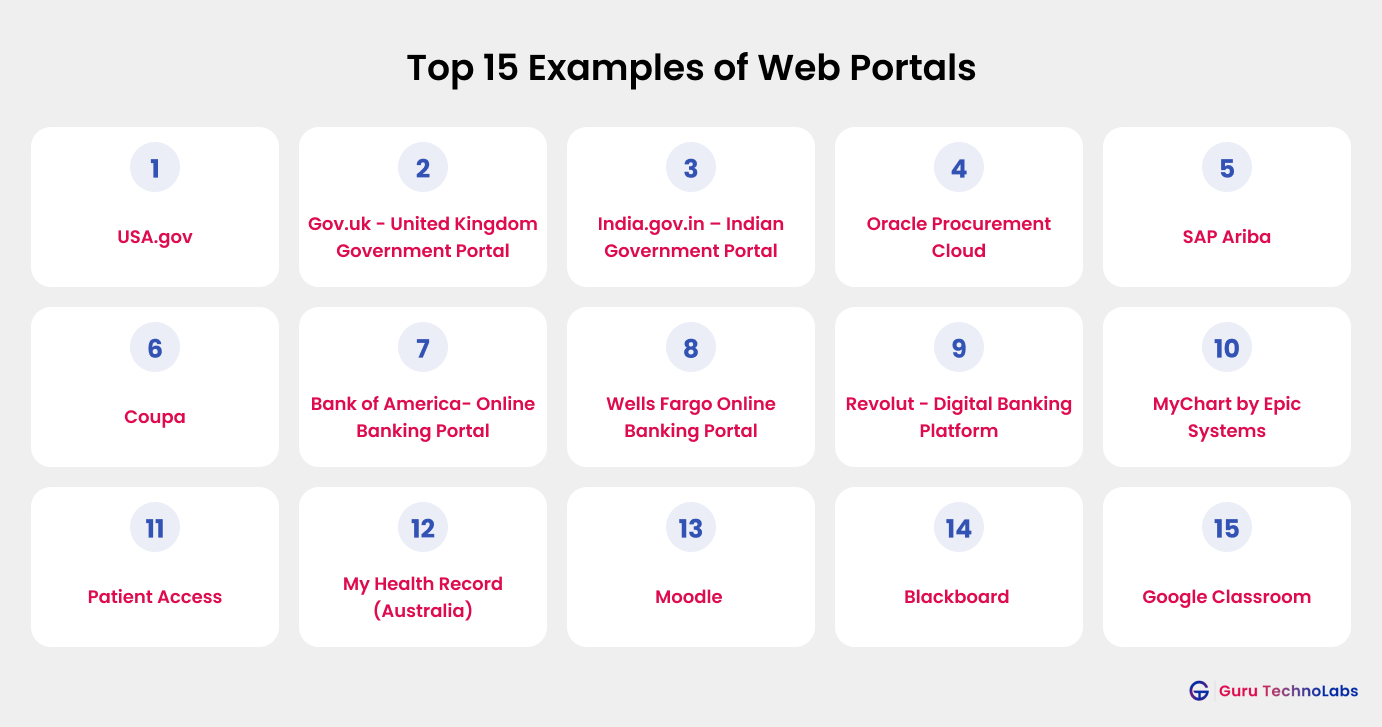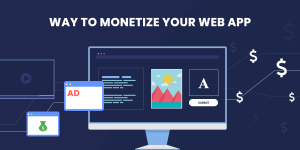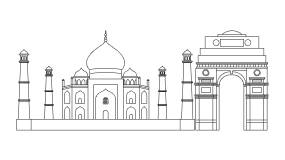15 Best Web Portal Examples for Inspiration (2025)

Don’t put all your eggs in one basket – but what if that basket could carry everything you need and more? That’s exactly what web portals offer. They bring together everything you need in one place, combining the convenience of central access with personalized features.
Unlike regular websites that usually serve just one purpose, web portals offer many services and tools all in one spot. They’re not just for finding information, they deliver it in a way that’s easy to use and tailored to each user.
In 2025, web portals will become more advanced than ever. They’re no longer just static pages with limited use. Modern web portals adjust to each user, offering customized experiences based on individual needs and preferences.
If you’re still wondering how web portals differ from traditional websites, check out our detailed guide on the difference between websites and web portals.
In this post, we will examine 15 inspiring web portal examples that combine smart design, great features, and user-friendly experiences, showing how portals are leading the way in keeping users engaged.
Top 15 Examples of Web Portals

There are many types of web portals out there, each built to serve different industries and purposes, like government services, education, or business. No matter the use, web portals are designed to give users quick and personalized access to the information and tools they need.
Below, we’ve listed 15 great web portals examples, organized by category, so you can explore how each one works and what makes them stand out.
Government Web Portal Examples
Government portals are digital platforms that provide citizens and businesses with access to a wide range of public services and information. They simplify the bureaucratic process, enabling users to apply for permits, pay taxes, access benefits, and stay informed about policies.
By centralizing government services in one place, portals promote transparency, efficiency, and convenience. They also enhance communication between the government and the public, streamlining service delivery and fostering greater citizen engagement.
1. USA.gov
USA.gov is the official web portal for the United States government, acting as a central hub for all federal, state, and local government services and information. The portal simplifies access to government-related resources, making it easier for citizens to obtain forms, apply for benefits, and stay updated with public policies.
It is designed to help citizens navigate the complex landscape of government programs efficiently and effectively.
Key Features:
- Comprehensive search engine
- State-specific information
- Service applications
- Dataset downloads
- API Access
- Dataset browsing
2. Gov.uk – United Kingdom Government Portal
The UK government’s official web portal offers citizens a single point of access to government services and policies. This portal consolidates information from hundreds of government departments into a user-friendly interface, allowing individuals and businesses to find essential services and important updates.
Key Features:
- Unified access
- Service application forms
- Clear information design
- Search functionality
- Policy and procedures
- Well-designed menu
3. India.gov.in – Indian Government Portal
India.gov.in is the official online portal for the Government of India. It serves as a one-stop solution for accessing government services, policies, and information. Indian citizens can access services like birth and death certificates, pensions, and public sector schemes. The portal aims to enhance transparency, efficiency, and ease of access to government functions.
Key Features:
- Wide service access
- Information on welfare schemes
- Complaint redressal
- News highlights
- WebCast services
- Mobile App Directory
Vendor Portal Examples
Vendor portals are essential platforms for businesses and suppliers to interact efficiently with their clients. These web portals allow suppliers to submit cards, manage contracts, track orders, and handle payments seamlessly and in order.
Vendor portals digitalize procurement processes, improving transparency, reducing delays, and helping companies maintain a smooth supply chain. They also enable businesses to better manage their relationships with vendors, ensuring timely deliveries and fostering collaboration.
4. Oracle Procurement Cloud
Oracle Procurement Cloud is a comprehensive cloud-based web portal solution that helps businesses manage procurement, supplier relationships, and supply chain operations more effectively. The platform focuses on automating processes, enhancing collaboration, and enabling better decision-making through real-time analytics.
Key Features:
- Automated Invoice Processing
- Inventory Management
- Supplier Risk Identification
- Procurement Analytics
- Track Environmental Impact
- Chatbot Support
5. SAP Ariba
SAP Ariba is a global procurement portal designed to simplify sourcing and supply chain management processes. By providing a unified platform, it helps businesses improve supplier collaboration, optimize costs, and effectively manage contracts and purchase orders.
Key Features:
- Supplier Collaboration
- Contact Automation
- Spend Analysis
- Trials and Demos
- Catalog Management
- Ariba Exchange
6. Coupa
Coupa is a cloud-based spend management platform that focuses on procurement, supplier management, and spend analytics. It helps organizations gain control over their spending, optimize supplier relationships, and streamline procurement workflows.
Key Features:
- Procurement Management
- Supplier Management
- Mobile Access
- Invoicing
- Coupa Treasury
- Cash Management
Finance and Banking Web Portal Examples
FinTech web portals are digital platforms designed to provide financial services such as payment processing, online banking, and investment management. These portals empower users to carry out transactions securely, monitor spending, and access a range of financial products.
With features like real-time analytics, mobile access, and customer support, these FinTech web portal examples are revolutionizing how individuals and businesses manage their finances. By enabling easy, accessible financial services, they promote financial inclusion and improve overall economic efficiency.
7. Bank of America- Online Banking Portal
Bank of America’s online banking portal offers a comprehensive suite of financial services that allows customers to manage their accounts, make payments, and access financial tools. The platform is designed to provide a seamless banking experience with high-level security features.
Key Features:
- Account Management
- Bill Payment
- Mobile Check Deposit
- Transfer Funds
- Security Alerts
- Financial Insights
8. Wells Fargo Online Banking Portal
Wells Fargo’s online banking platform makes it easy for customers to manage their finances. The website portal example offers a wide range of tools and services, from account management to investing, and ensures that all banking needs are met securely and efficiently.
Key Features:
- Account Overview
- Budgeting Tools
- Online Transfers
- Fraud Protection
- Loan Management
- Investment Tracking
9. Revolut – Digital Banking Platform
Revolut is a digital bank that offers a wide variety of financial services, from currency exchange to stock trading. It’s known for its ease of use and global accessibility, making it a popular choice for individuals looking for a more modern, mobile-first approach to banking.
Key Features:
- Multi-currency Accounts
- Peer-to-Peer Payments
- Crypto Trading
- Global ATM Withdrawals
- Real-time Spending Notifications
- Budgeting & Analytics
Patient Web Portal Examples
Patient portals are secure online platforms that allow individuals to manage their healthcare needs from the comfort of their homes. These portals provide access to medical records, lab results, prescriptions, and appointment scheduling, helping patients stay informed about their health.
They also enhance communication between patients and healthcare providers, making it easier to ask questions or request follow-up care. By streamlining healthcare processes, these internet web portal examples improve the patient experience and support better health outcomes.
10. MyChart by Epic Systems
MyChart is a patient portal that allows individuals to manage their healthcare and access medical records, lab results, and prescriptions. Developed by Epic Systems, it enhances communication between patients and healthcare providers, making healthcare management more convenient.
Key Features:
- Lab Results Access
- Prescription Refills
- Secure Messaging
- Health Reminders
- Educational Resources
- Test Result Viewing
11. Patient Access
Patient Access is an online portal designed to facilitate patient’s access to healthcare services. It integrates with various healthcare systems to allow individuals to view test results, request prescriptions, and schedule appointments online.
Key Features:
- Appointment Scheduling
- Secure Test Results
- Direct Communication
- Billing and Payments
- Geolocation
- Notifications and Alerts
12. My Health Record (Australia)
My Health Record is Australia’s national digital health record system. It securely stores an individual’s health information and allows for easy sharing between healthcare providers. This key initiative aims to improve the coordination of care for Australian citizens.
Key Features:
- Health Record Access
- Emergency Access
- Integrated Health Services
- My Health App
- Online Learning Sessions
- Telehealth
Education Web Portal Examples
Education portals are web-based platforms that facilitate learning and administrative tasks for students, teachers, and institutions. They offer a range of services, including course registration, assignment submissions, and access to educational resources.
Education web portals improve communication between students and instructors, making it easier to track progress, participate in discussions, and access course materials. By promoting online learning and simplifying administrative tasks, education portals enhance the overall learning experience and support remote education.
13. Moodle
Moodle is an open-source learning management system (LMS) used by schools and universities worldwide to deliver online education. It allows instructors to create customized lessons, quizzes, and learning materials for students.
Key Features:
- Course Creation Tools
- Student Progress Tracking
- Collaborative Learning
- Supports 160+ Languages
- Mobile Learning
- Easy Add-ons
14. Blackboard
Blackboard is a comprehensive online learning platform that helps educational institutions manage courses, assessments, and interactions. Universities widely use it for its robust learning and communication tools.
Key Features:
- Course Management
- Assessment Tools
- Mobile Accessibility
- Grading
- Content Libraries
- Virtual Classrooms
15. Google Classroom
Google Classroom is a free learning management system designed by Google that integrates with G Suite tools, making it an excellent choice for schools, teachers, and students to organize assignments, communicate, and collaborate.
Key Features:
- Assignment Submission
- Google Integration
- Real-time Communication
- Live Classes
- Announcements
- Virtual Discussions
Want to Enter the Online Learning Era with Smart Solution?
Get started with our educational app development services and climb the
ladder of success in no time.
Why Should You Consider Building a Web Portal?
Web portals have become an essential part of how organizations deliver personalized, efficient, and centralized digital experiences. Whether you’re running a business, school, government service, or financial platform, a well-designed portal can make it easier for users to access the tools and information they need, all in one place.
By building a web portal, you can improve user engagement, streamline services, and offer secure access to resources based on user roles or preferences. Portals are also great for managing data, supporting remote access, and integrating different systems under one platform.
At Guru TechnoLabs, with top-notch web development services, we help businesses create powerful and user-friendly web portals tailored to their specific needs. With the right technology and a clear strategy, your web portal can become a key driver of digital growth and user satisfaction.
If you’re thinking about building a web portal, now is a great time to start exploring the possibilities.
Frequently Asked Questions
The web portal is an online platform that acts as a gateway, providing users with easy access to various services, resources, and information. It centralizes content, making it easily accessible and manageable for users.
Web portals can be classified into several types, including: 1. Government Portals: For public services and information. 2. Vendor Portals: For supplier management and procurement processes. 3. Employee Portals: Used by organizations for internal communication and document management. 4. Educational Portals: For learning resources and student-teacher interactions. 5. Healthcare Portals: For patient information, medical records, and appointment management.
Horizontal portal offers a wide range of general content and services to a broader audience. Examples include platforms like Yahoo or MSN, which provide news, email, search, and various other features for all types of users.
Building a web portal involves several steps, such as planning the design, selecting the right technologies, and ensuring security. Working with an experienced web portal development service provider is crucial to ensure the portal meets your specific business needs.
Web portals are platforms designed to provide various services and centralized content, whereas websites usually focus on a single purpose or company offering.
Yes, modern web portals are designed to be mobile-friendly, ensuring they work seamlessly on smartphones and tablets, allowing users to access them on the go.
Web portals can be integrated with third-party systems such as CRM, ERP, and payment gateways to improve efficiency and streamline business processes.
Web portals are usually built using a combination of front-end technologies like HTML, CSS, and JavaScript, back-end technologies like PHP, Java, and Python, and databases such as MySQL or MongoDB.





















